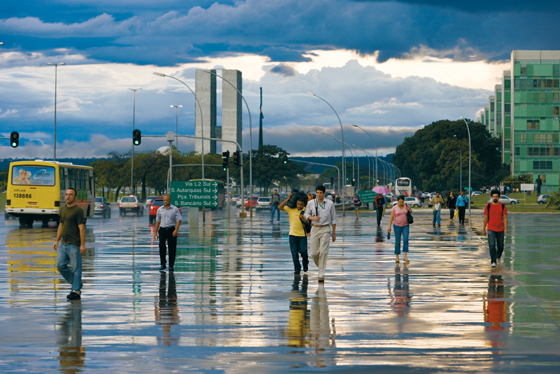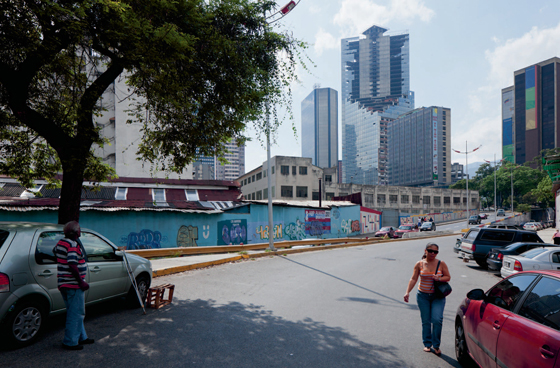Bodies of Evidence: architecture, photography and real lives
Texto por Simon Keane-Cowell
Zürich, Suiza
29.08.13
There's a long tradition of architectural photography presenting viewers with depopulated spaces – interior and exterior landscapes, devoid of the very users for which they have been designed. Celebrated Dutch photographer IWAN BAAN's unparalleled documentary images of the built environment correct this lack, putting people back in the picture.
....
Le Corbusier's Chandigarh, India, photographed by Iwan Baan. Taken from 'Brasilia – Chandigarh, Living With Modernity', Lars Müller Publishers, 2010
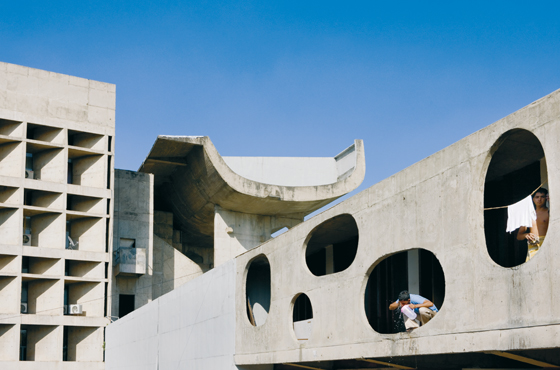
Le Corbusier's Chandigarh, India, photographed by Iwan Baan. Taken from 'Brasilia – Chandigarh, Living With Modernity', Lars Müller Publishers, 2010
×Hell is other people. According to Jean-Paul Sartre, that is.
The love-him-or-hate-him French existentialist has one of his characters in his 1944 play ‘No Exit’ utter these infamous words, having been locked in a room for eternity with two other unfortunates. Given the circumstances, you can forgive him the sentiment.
The enforced sharing of space is something that most of us don’t relish, which may be one of the reasons why architectural photography has traditionally chosen to show spaces that are evacuated of the users for whom they’ve been designed. Browse through an online architectural blog and you’re more often than not presented with images of interiors and outdoor spaces – both private and public – devoid of people. It’s easier to find the photograph of a building or an environment seductive when it’s presented as a fantasy space ready for the viewer to occupy mentally. And there’s an argument there, too, that the technical detail of an architectural project can only truly be appreciated by the observer when it is laid bare – and this means free of obscuring bodies.
Photographer Iwan Baan's images of modernist cities Brasilia (top) and Chandigarh (above) reveal the disparity between architectural intention and lived reality. Photos: 'Brasilia – Chandigarh, Living With Modernity', Lars Müller Publishers, 2010
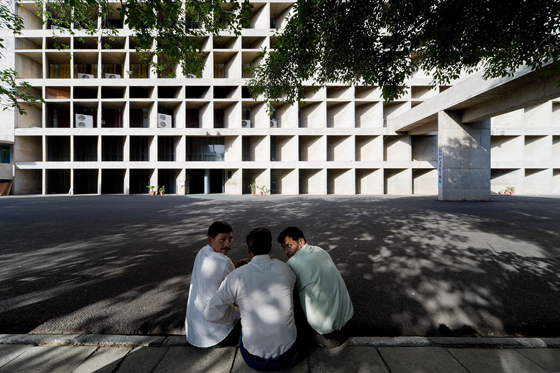
Photographer Iwan Baan's images of modernist cities Brasilia (top) and Chandigarh (above) reveal the disparity between architectural intention and lived reality. Photos: 'Brasilia – Chandigarh, Living With Modernity', Lars Müller Publishers, 2010
×Le Corbusier’s oft-cited maxim that the house should be ‘a machine for living’ becomes more than a little ironic when its visual dissemination through photography chooses to promote the built realm as an uninhabited landscape. The modernist movement of the early 20th century embraced the photographic medium as a key means of communicating its ideas, but what this, for the most part, chose to show were interiors and exteriors unaffected by human presence. Still lifes rather than depictions of living. Think of those much-published images of Le Corbusier’s iconic Villa Savoye or Gerrit Rietveld’s Schröder House, or Austrian architect Margarete Schütte-Lihotzky’s 1926 Frankfurt Kitchen, which posit their radically new spaces, expressive in their formal reduction, as empty stage sets. If the machine was created for everyday living, its image-based marketing, as it were, consciously or unconsciously disavowed that everyday use, choosing to present the machine at a standstill.
Not so the work of feted American architectural photographer Julius Shulman. Credited with having immortalised mid-century US modernist architecture (and, indeed, helping position architectural photography as a discipline in its own right), Shulman, who worked closely with many of the leading exponents of the contemporary architectural style that was to become synonymous with California, put people in the picture. Yet his most published photographs from the 1950s and 60s – among them Pierre Koenig’s Los Angeles Case Study House #22 and Buff, Straub and Hensman’s Mirman Residence in Arcadia – can be seen as exemplifying the ideological function that Shulman’s image-making came to perform: the houses’ residents are, albeit in an archly contrived manner, depicted as living the domestic dream, engaged in various social and leisure activities. What’s being sold here is as much the fantasy of a particular contemporary, sun-drenched lifestyle as the credentials of the architect whose work forms the platform for such California dreaming. In a word, it’s propaganda.
Vilified locally as a 'vertical slum', Caracas's 45-storey Torre David – a half-built commercial tower block turned vertical squat – speaks out through Iwan Baan's images. Photos: 'Torre David: Informal Vertical Communities', Lars Müller, 2013
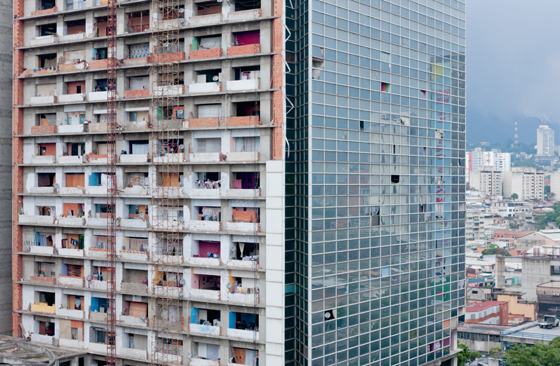
Vilified locally as a 'vertical slum', Caracas's 45-storey Torre David – a half-built commercial tower block turned vertical squat – speaks out through Iwan Baan's images. Photos: 'Torre David: Informal Vertical Communities', Lars Müller, 2013
×If there’s one photographer working currently whose work eschews the staged in favour of showing in an objective way as possible the real relation between people and the built environment, it’s Iwan Baan. The internationally celebrated Dutch image-maker, who shuns the term ‘architectural photographer’, arguing that it is limiting given his concern not with architecture as a set of sacred spaces, but rather as a series of contexts or sites of negotiation – places that are given meaning through the way in which they are used – chooses to ‘stay in the background and document the things that are happening in front of my lens’. There’s a touch of irony, of course, in Baan winning the first annual Julius Shulman Award in 2010, given that his work is more of an act of bearing witness to the architecture as lived with than a promotion of architecture as lifestyle.
Iwan Baan’s 2010 book ‘BRASILIA – CHANDIGARH: Living with Modernity’ (Lars Müller Publishers) sealed his credentials as a documentarist, recording as it does, in a resolutely observational way, just how the populations of these two cities, built on the foundations of the modernist ideals of social progress, are choosing and having to live decades after they were first created. The photographs examine the, at times, striking disparity between Oscar Niemeyer and Le Corbusier’s urban schemes as architectural manifestos and the unscripted reality of their day-to-day use. Both Brasilia and Chandigarh can be seen evincing the way in which architecture is always only a work in progress, its users shaping its design through their continuous presence.
'A city within a city.' Torre David is both ad-hoc – consisting of dwellings and other spaces that have been repurposed through the use of found materials – and highly organised. Photo: 'Torre David: Informal Vertical Communities', Lars Müller, 2013
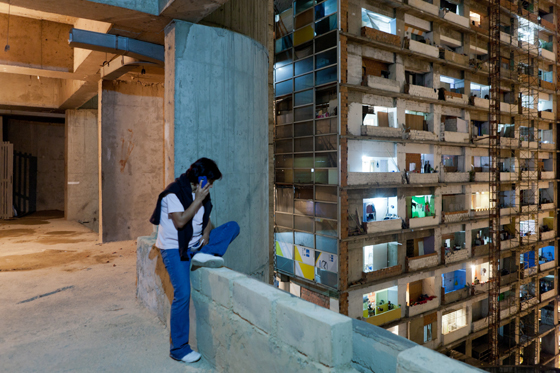
'A city within a city.' Torre David is both ad-hoc – consisting of dwellings and other spaces that have been repurposed through the use of found materials – and highly organised. Photo: 'Torre David: Informal Vertical Communities', Lars Müller, 2013
×The non plus ultra of this process can arguably be found at Torre David in Caracas, Venezuela, an ambitious 45-storey corporate tower block, construction of which began in 1990, but which was abandoned mid-build a couple of years later due to the untimely death of the developer and a national banking crisis. Situated in the central business district, the city’s second-tallest structure (which had been destined to house a hotel and office space) saw squatters begin to take up residence in 2007 and is now home to almost 3,000 of Caracas’s formerly dispossessed. Out of a half-completed commercial building, they have created what Baan describes as a ‘living organism’; a proud community have, with a high degree of creativity, adapted the structure to meet their own needs. (Torre David now houses, in addition to private dwellings, a range of common areas, including a basketball court, church, and a number of shops, and residents have also installed their own electricity and water supplies.)
Despite the often negative publicity this act of appropriation and adaption by the city’s poor has generated within Venezuela, Baan’s photographic documentation of the place, collected in the 2013 book ‘Torre David: Informal Vertical Communities’ (Lars Müller Publishers) presents a different kind of narrative – one where architectural space is co-opted and brought to life by the people who inhabit it – in an as undistorted and unmediated way as possible. This is architectural history written at a popular level and communicated through that most immediate form of representation – the image.
Hell may be other people, but these pictures show a community gazing at the stars.
Shops, a basketball court and a church are some of the public spaces created by the 3,000-strong community of Torre David for the community. Photo: 'Torre David: Informal Vertical Communities', Lars Müller Publishers, 2013
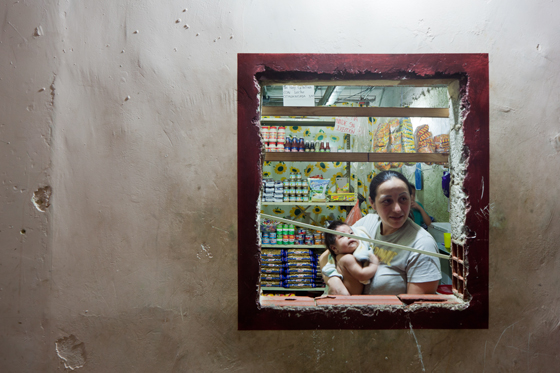
Shops, a basketball court and a church are some of the public spaces created by the 3,000-strong community of Torre David for the community. Photo: 'Torre David: Informal Vertical Communities', Lars Müller Publishers, 2013
×…
ARCHITONIC: How did the Torre David photographic project come about?
IWAN BAAN: I was in Caracas for the first time four years ago or so for the ‘Small Scale, Big Change’ MoMA show by Andres Lepik, and that’s how I met the guys from Urban-Think Tank. I was immediately fascinated by the city, a place where 70% of the population lives in limbo, in slums, in the favelas, surrounding the city. And while going through town I heard about this tower that was right in the centre of Caracas, its second highest building. Very visible in the city. I heard from Urban-Think Tank and from others stories about what was happening inside. It was a kind of off-limits places with no outsiders going in and considered quite dangerous. So we felt we should really document this and see what was really happening inside. But it took us a long time to gain the trust of the people in there. Nine months later I went in for the first time and couldn’t believe my eyes what was happening.
Did you go in with a certain set of ideas of what you were hoping to show, based on what you’d heard, or was it a case of letting the narrative create itself?
Yes, that’s usually how I work. In a very intuitive way, you see what’s happening in these places, what the strengths are, what people are doing there. I’d never seen something like [Torre David]. In a way, it’s complete anarchy, like how it started. People just squatting and making liveable space out if it. And at the same time it’s completely organised. Like a city within a city. They have their own security, systems for water and electricity. All the things you see in a real city. They were mimicked there on a small scale for almost 3,000 people.
'I choose to stay in the background and document the things that are happening in front of my lens,' explains Iwan Baan. Photo: ''Torre David: Informal Vertical Communities', Lars Müller Publishers, 2013
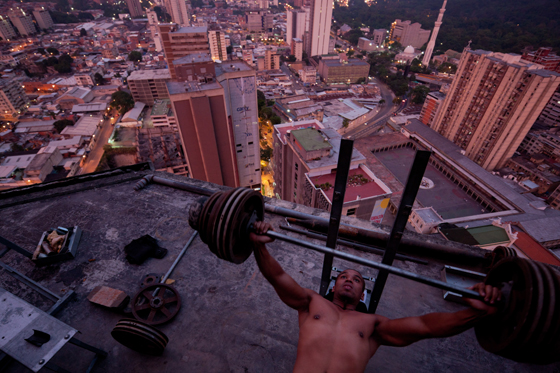
'I choose to stay in the background and document the things that are happening in front of my lens,' explains Iwan Baan. Photo: ''Torre David: Informal Vertical Communities', Lars Müller Publishers, 2013
×What was the process, once you were inside and had gained their trust? Did you have the freedom to move about the various spaces and photograph what you wanted or was there some negotiation involved?
I went there a number of times over the period of a year and a half. Slowly you get to know these people better. At first they are very wary of journalists and outsiders coming in. There’s a lot of negative press about the project in Venezuela. Once you get in, people are so proud of what they’ve created, they want to show you everything. They take you into all these places where people do it themselves, with found materials, things they can get their hands on. So there’s this incredible sense of pride and ownership of this place. They didn’t have anything before and now they have created this living organism.
Is there a telling of the truth in a project like this? Is truth a word that could be applied to what you do?
The objectivity of photography is of course always a big debate. As a photographer I try to stay in the background and document the things that are happening in front of my lens. So yes, it’s not about your particular fascinations as a photographer, but what people are doing, what’s going on in that particular moment.
Urban-Think Tank have written about their concern with ‘the ethical and moral role of the architect in society’. Is there a similar role for photographers who deal with the built environment, for example going into a place like Torre David?
I think these kinds of stories are important to tell. To bring out what’s happening in Venezuela, a country that is in such chaos and turmoil, but also to see how people under such circumstances find a way to live and find a way to create their own space and really create a place for themselves. These are the kinds of things that you try to tell to the world, as a photographer, in your pictures.
....
Torre David: Informal Vertical Communities
Urban-Think Tank, Chair of Architecture and Urban Design
ETH Zürich
Photographs by Iwan Baan
Lars Müller Publishers
16.5 x 24 cm, 416 pages, 406 illustrations
ISBN 978-3-03778-298-9, English
BRASILIA–CHANDIGARH: Living with Modernity
Iwan Baan, Cees Nooteboom
Lars Müller Publishers
24 x 30 cm, 240 Seiten, 200 Abbildungen
ISBN 978-3-03778-228-6, Englisch

